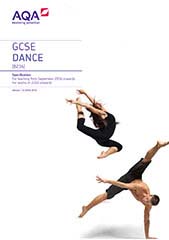3.1 Performance
Students must develop and apply the following knowledge, understanding and skills to perform dance as a soloist for approximately one minute and in a duet/trio for a minimum of three minutes.
The total duration of a student’s performance must be no less than three and a half minutes.
| Knowledge, understanding and skills for performance | |
|---|---|
| Physical skills and attributes, including: |
|
| Technical skills, including: |
|
| Expressive skills, including: |
For duet/trio performance only:
|
| Mental skills and attributes (during performance), including: |
|
| Safe working practices (during performance), including: |
|
| Mental skills and attributes (process), including: |
|
| Safe working practices (process), including: |
|
Solo performance
Students must learn how to perform as a solo dancer for approximately one minute.
In conjunction with the student, the teacher must select two of the following set phrases for each student to perform as a soloist, from the choice of four set by AQA. The titles of the set phrases are as follows:- breathe
- flux
- shift
- scoop.
- physical skills and attributes safely during performance
- technical skills accurately and safely during performance
- expressive skills
- mental skills and attributes during performance.
In the assessed performance, the two phrases must be presented separately (not be linked together), but can be presented in any order. They must be performed to an audible beat of 105 BPM. They may not be performed to any other accompaniment.
See Assessment task 1: Performance for details of the assessment and Solo performance assessment grid for how it must be marked.
Recordings of the four set phrases, each lasting approximately 30 seconds, are available to view at aqa.org.uk/dance along with the teacher's notes.
Duet/trio performance
Students must learn how to perform as part of a duet/trio dance. Each student must perform for a minimum of three minutes in a dance which is a maximum of five minutes in duration.
The duet/trio dance may be choreographed by teacher(s), dance artist(s) or by collaboration between teacher(s) and/or dance artist(s) and students.
The duet/trio performance must have a clearly identified choreographic intent, which relates to mood(s), meaning(s), idea(s), theme(s) and/or style/style fusion(s) or a combination of these.
The action, dynamic and spatial elements of the remaining two set phrases from the choice of four set by AQA must be developed to generate dance content for the duet/trio performance and to realise the chosen choreographic intent.
It is not essential for the phrases in their original form to be included either in whole or in part in the resulting duet/trio, but they could be if this helps to realise the chosen choreographic intent.
The two phrases that have been used in a student’s solo performance must not be used again in their duet/trio performance.
The final performance for assessment must clearly reflect the defined choreographic intent, and ensure coverage of the performance content in a duet/trio context. This must include:- opportunities for students to demonstrate the additional knowledge, skills and understanding specific to duet/trio performances ie relationship content, musicality and sensitivity to other dancers
- opportunities for students to demonstrate safe practice at a challenging level, eg physical contact and interaction with other dancers, elevations, moving into and out of the floor at speed
- an appropriate aural setting.
Assessment of the duet/trio performance will focus on each students' ability to demonstrate application of:
- physical skills and attributes safely during performance
- technical skills accurately and safely during performance
- expressive skills
- mental skills and attributes during performance.
The dance content of the piece presented for assessment must be of sufficient sophistication, complexity and challenge to allow each student to access the full range of marks available.
Please refer to the online exemplification material available at aqa.org.uk/dance for marked examples of duet/trio choreography.
Documenting the duet/trio performance
To support assessors' marking of the duet/trio performance, teachers must provide a Programme note (approximately 150 words). The Programme note must include the following information:- the choreographic intent, eg the idea(s), theme(s), mood(s), meaning and/or style/style fusion(s) of the dance
- the phrases that have been used for each student in the creation of the piece
- citations of title and musician/artist for any aural accompaniment used.
Please see Assessment task 1: Performance for further details of the Programme note and assessment.
Students must be assessed individually within the piece performed, using Duet/trio performance assessment grid.
Students will also be required to demonstrate their knowledge and understanding of performance skills by responding to questions in the critical appreciation (Component 2) written exam.
